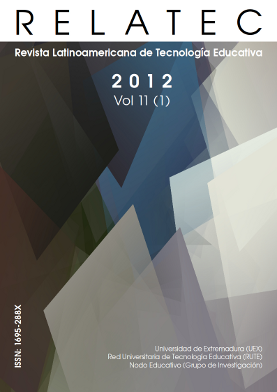Diseño y desarrollo de un entorno de aprendizaje colaborativo basado en la Web 2.0
Keywords:
Educación a distancia, Aprendizaje en línea, Internet, Educación superior, Alfabetización informacional.Abstract
En la era de la Sociedad de la Información y el Conocimiento, la competencia de trabajo en equipo se postula como una de las más importantes en el ámbito profesional. Siendo conscientes de ello, llevamos realizando, desde sus inicios, una serie de asignaturas en las que los estudiantes se inician en las competencias TIC mediante la realización de pequeños proyectos de investigación en equipo. Dichas asignaturas han ido evolucionando y adaptándose no sólo al Espacio Europeo de Educación Superior (EEES) sino, que, también, al uso emergente de las tecnologías Web 2.0. El objetivo de este artículo es el de ilustrar el proceso de diseño e implementación de un nuevo espacio de trabajo en equipo basado en la Web 2.0 para el desarrollo de actividades colaborativas en una de las asignatura de la Universitat Oberta de Catalunya (UOC). Dicho espacio, desarrollado mediante un proyecto interno de innovación en nuestra universidad, permite un mayor grado de flexibilidad en su configuración, de tal forma que resulta fácilmente adaptable a las necesidades de enseñanza y de aprendizaje propias de cada asignatura. Para llevar a cabo el proceso de implementación del espacio se llevaron a cabo dos pruebas piloto: una con docentes y otra con estudiantes. Con la finalidad de recoger resultados que nos permitan desarrollar mejoras en dicho espacio, se diseñó un cuestionario. En este artículo se exponen dichos resultados señalando sus virtudes como entorno de aprendizaje.
In the Information Society and Knowledge era, teamwork competence is postulated as one of the most important in the professional field. Being aware of that, a series of introductory courses have been developed at UOC. In these courses, students are initiated into the ICT competences by conducting small research projects in teams. These courses have been adapted to the European Higher Education Area (EHEA) and the emerging use of Web 2.0 technologies. The aim of this paper is to illustrate the process of design and implementation of a collaborative environment based on Web 2.0 tools that is used to carry out collaborative learning activities. In order to use the environment presented in this paper, students and teachers pilot tests were developed. With the aim of gathering results to improve the environment, a survey was designed. In this paper the main results are exposed, regarding its benefits to learning and teaching processes.
Downloads
Downloads
Published
Issue
Section
License
Authors who publish in this journal accept the following conditions:
1. The Author retains copyright in the article. Upon acceptance of the article, the author shall grant to the Publisher the right of first publication of the article. with the dcoument registered with the Creative Commons Attribution-NonCommercial-NoDerivative 4.0 International (CC BY-NC-ND) license, which allows to third parties to use what is published whenever they mention the authorship of the work and the first publication in this journal.
2. Authors can make other independent and additional contractual agreements for the non-exclusive distribution of the article published in this journal (eg, include it in an institutional repository or publish it in a book) provided they clearly indicate that the work was published for the first time in this journal.
3. Authors are allowed and recommended to publish their work on the Internet (for example on institutional or personal pages) before and during the review and publication process, as it can lead to productive exchanges and a greater and faster diffusion of published work (see The Effect of Open Access).









